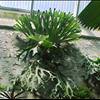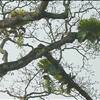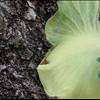This plant may be available to buy
Click the banana to see

|
Staghorn Fern click pic to enlarge |
|
Staghorn ferns are epiphytic perennials or "air" plants. Staghorns are native to jungles in Africa, Madagascar, Australia, Tropical Asia and one species (Andinum) is from South America, Peru and Bolivia click pic to enlarge Staghorn ferns can be found high in tall trees attached to, but not growing "in" the bark. What that means is stags don't need or use soil as do land plants Not all species are from the jungle. Platycerium veitchii grows on rocks in semi-desert Australia They get their nutrition substantially from the air. Pretty amazing, eh? Stags are therefore in the same class as orchids, for example, which also mostly grow in trees with no soil Stags have two kinds of fronds: the green fertile fronds and the brown sterile fronds click pic to enlarge Mom's Mahogany tree The fertile fronds are the large protruding leaves which also grow spores (underside at tips) for reproduction. The sterile fronds are round (green at first) brown fronds which surround groups of fertile fronds at the base of each group. Platycerium have no flowers NOTE: Don't think your stag is sick or has a disease when you see brown fuzzy patches appear on the bottom side of the tips of older larger fertile fronds. These are the spores. Leave them alone :-) If you are given a staghorn fern or buy one, it is probably mounted on a wooden board. However, some people like to hang staghorn ferns from chains under large trees to form a ball of foliage and here too To mount directly to a tree, we like to use fishing line. In time, new fronds cover the line click pics to enlarge Here's a properly mounted stag in a Gumbo Limbo tree click pic to enlarge To attach a stag to a board, prepare some sphagnum moss by soaking the moss in water (rain water is best) for about 4 hours to hydrate the material. Sphagnum moss is NOT peat moss and must be label Sphagnum, available at Amazon and other online retailers The mounting board you select should be a hard wood, like oak or mahogany, and as large and thick as you like. You could also use pecky cypress or redwood. Your stag will grow sideways so the larger the board you start with, the longer your stag can remain growing undisturbed If you use a small board, you will very likely have to re-mount your stag on a larger board in the future. If you live in South Florida (climate zone 10) or Hawaii or another tropical area, you can mount your stag directly on a fine hardwood tree On the back of your board, attach a very strong hook or wire loop or steel chain to support your stag when hanging. This must be very strong because your stag will get very heavy in the future, especially after soaked with rain. Use strong screws versus nails. Get heavy duty hardware for this job On the front (mounting) side of your board, tack in small nails in a pattern an inch or two larger than your stag. Now place some of your soaked sphagnum moss in the center of the nails (the center of your board). Lay your stag down onto the moss with the fertile frond tips up...the same direction as your mounting hook Get some light see-through fishing line, say 5-pound test line. Tie one end of the fishing line to one of your nails. Cross over the stag to the opposite nail. Keep crossing your stag with fishing line and attaching to your nails until your stag is firmly mounted NOTE: As your stag grows, it will grow over the mounting fishing line and therefore disappear from view You will disturb your stag a little in doing this, especially you will wipe off some of its protective "fuzz" that looks like fine white hairs. Try to limit this wipe-off damage as much as possible If you have a small stag, you could also use strips of panty hose instead of the fishing line. The advantage of the panty hose is they will disintegrate in about a year. At that point your stag should be nicely attached to your board You now must select a location to hang your stag. Outdoors is best, of course Bright light but no direct sun is ideal, like this happy old stag here Like in the picture, it's OK to let old, spent, brown fronds go to dry ...they easily pull out at that stage Your stag can handle some sun, but early morning sun only. In the wild, they always have a leaf canopy over them producing broken shade...so approximate this condition as best as possible. Do not allow windy conditions either Feed you stag with organic food such as fish emulsion fertilizer. Another good trick is to place a banana peel (peel only) behind the stag...between the stag and the board. They like the potassium Most people over water their stags Water about once a week and soak the moss to do so. The water will pour through quickly so you'll have to apply a lot of water to get a little wetness in the moss...if you have let it dry out too much. If you keep the moss moderately moist, this will not be a problem. Again, water with rain water if possible. Collect the rain off your roof in a bucket for your stag MORE STAGHORN FERN INFO: To re-mount a stag, you can nail or screw the old board onto a new larger board. You could also use a knife to cut down between the board and the moss and dis-mount your stag, then re-mount it on a new board You can cut your stag into pieces. As stags grow, they form new individuals each with a sterile frond at the center with fertile fronds protruding. Use a knife to cut individuals off a mother plant and re-mount the babies. Some may die but most will live through this surgery Indoors, keep your stag out of the way of hot or cold blowing air There is no particular care for your staghorn fern except to provide the proper conditions as explained throughout the text above Outdoors, leaves and other airborne materials will fall onto the moss backing your staghorn. As these materials decay, they provide added food for your stag Most staghorn varieties are very easy to grow. However, some are very difficult and can very easily be killed by fungus, usually via too much water If you have a staghorn fern, it is probably Platycerium bifurcatum. Other varieties include grande, willinckii, hillii, coronarium, veitchii, alcicorne and sumbawnse Do not touch your stag and thereby remove the protective fuzz. You will not specifically harm your stag touching/removing this fuzz but better to leave it alone Some named Platycerium varieties include:
|





